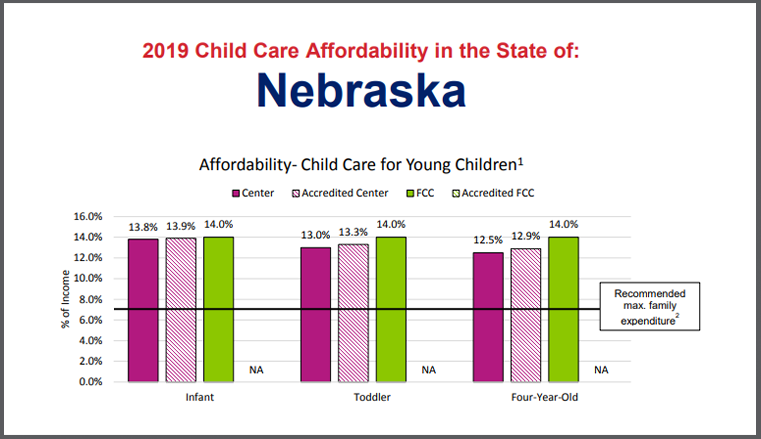Nebraska may be the good life for many, but employers statewide are facing serious challenges when it comes to attracting and retaining talent. That’s not great news for a state with approximately 60,000 open jobs and a 3.0% employment rate. [1]
Unfilled jobs, absenteeism and employee turnover have a big impact on business growth and workplace productivity. One contributing factor—the child care conundrum. If you’re an employer with working parents on staff, you can bet a large part of their time, energy and finances are spent finding reliable, affordable and quality care for their youngest children. It’s a challenge that impacts their income, quality of life and ability to stay engaged at work.
Here are three questions every Nebraska employer should ask about how child care impacts working families and a company’s bottom line.
How much are my employees paying for child care?
The cost of child care varies widely based on quality and location. Some Nebraska families with young children may be spending as much as 14% of their household income. In 2018, Child Care Aware ranked Nebraska among the top 10 least affordable states for child care for infants and 4-year-olds in both family-home and center-based child care.[2] The average annual child care cost in Nebraska was $12,480 for a single infant, and $24,960 for an infant and a 4-year old.[3] By comparison, that’s higher than the 2017 average cost of $7,732 for tuition and fees at a Nebraska public, in-state university.[4]
The high cost of care can keep parents up at night as they struggle to balance their budgets or consider long-term career changes in search of higher salaries. Some parents may choose to stop working altogether to become full-time caregivers or miss out on opportunities for career growth. As an employer, think about the average earnings of your employees and how much they can expect to pay for child care in your community. Are there solutions you can offer to help ease the financial burden?
How do my business or shift hours impact my employees’ child care arrangements?
Finding child care that fits varying work schedules can be difficult, especially for workers with hours beyond the traditional 9 to 5. Industries like health care, manufacturing, agriculture and transportation often require rotating or overnight shifts, mandatory overtime or out-of-town travel. Many providers don’t cover non-traditional hours or provide part-time care, so parents turn to family members, friends or unlicensed caregivers. If you’re an employer whose business or industry requires non-traditional hours, are there providers in your community available to meet your workers’ child care needs?
What child care options are available?
High-quality care can be hard to come by, especially in Nebraska’s rural communities. As long-time providers retire and close their businesses, parents may find themselves driving 30-45 minutes to find available care. That extra commute quickly adds up, and can lead to workplace stress, a loss of productivity or increased employee tardiness and absenteeism. As an employer, understand the child care infrastructure in your community and find out how far parents may need to travel for reliable child care.
Working parents who are supported with high-quality, affordable and reliable child care can commit to their professions, stay in jobs longer and miss fewer workdays. Employers who take a thoughtful approach to the child care challenge can go a long way in boosting employee satisfaction and retention and serve as a strong attractor for new workers.
[1] Nebraska Department of Labor, Labor Force Summary, August 2019.
[2] Child Care Aware, The U.S. and the High Cost of Child Care, 2018.
[3] Child Care Aware, The U.S. and the High Cost of Child Care, 2018.
[4] U.S. Department of Education, National Center for Education Statistics, Integrated Postsecondary Education Data System (IPEDS), Fall 2015 and Fall 2016, Institutional Characteristics component; and Spring 2016 and Spring 2017, Fall Enrollment component.
Graphic: Child Care Aware, The U.S. and the High Cost of Child Care, 2018.



